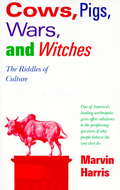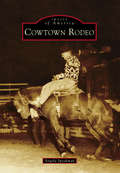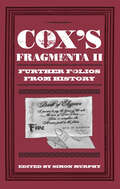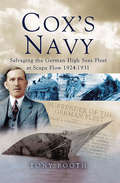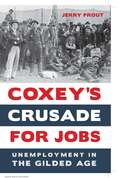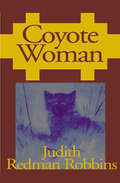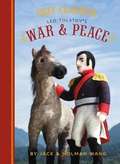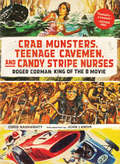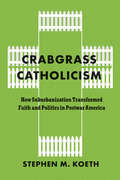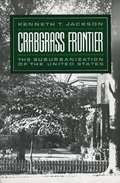- Table View
- List View
Cows, Pigs, Wars, and Witches: The Riddles of Culture
by Marvin HarrisOne of America's leading anthropolgists offers solutions to the perplexing question of why people behave the way they do.Why do Hindus worship cows? Why do Jews and Moslems refuse to eat pork? Why did so many people in post-medieval Europe believe in witches?Marvin Harris answers these and other perplexing questions about human behavior, showing that no matter how bizarre a people's behavior may seem, it always stems from identifiable and intelligble sources.
Cowtown Rodeo (Images of America)
by Angela SpeakmanAn enormous red cow and a 20-foot-tall cowboy have long welcomed all who arrive at the Cowtown Rodeo and Flea Market. In the 1920s, Amos Howard Harris was auctioning automobiles in a livestock town. Realizing he needed to appeal to the locals, he and his son began hosting weekly livestock auctions and inviting local merchants to attend and sell their goods. The idea was a success. In 1929, the Harris family and Cowtown helped revive the local annual fair and rodeo, which continued to exist until World War II. With the popularity of the auction and the growth of the midway market, the operation moved to a larger location in 1940. Then, 15 years later, Cowtown hosted its first full rodeo season. Today, it is the longest continually running weekly professional rodeo in the country. It remains a Harris family business and a South Jersey tradition, attracting visitors from around the world.
Cowtown Wichita and the Wild, Wicked West
by Stan HoigBefore she was Wichita, Kansas, she was a collection of grass huts, home to the ancestors of the Wichita Indians. Then came the Spanish conquistadors, seeking gold but finding instead vast herds of buffalo.After the Civil War, Wichita played host to a cavalcade of Western men: frontier soldiers, Indian warriors, buffalo hunters, border ruffians, hell-for-leather Texas cattle drovers, ready-to-die gunslingers, and steel-eyed lawmen. Peerless Princess of the Plains, they called her.Billy the Kid, Wyatt Earp, and Bat Masterson were here, but so were Jesse Chisholm, Jack Ledford, Rowdy Joe and Rowdy Kate, Buffalo Bill Mathewson, Marshall Mike Meagher, Indian trader James Mead, Oklahoma Harry Hill, city founder Dutch Bill Greiffenstein, and a host of colorful characters like you've never known before.Stan Hoig depicts a once-rambunctious cowtown on the Chisholm Cattle Trail, neighbor to the lawless Indian Territory, roaring and bucking through its Wild West days toward becoming a major American city. Cowtown Wichita and the Wild, Wicked West provides tribute to those sometimes valiant, sometimes wicked, sometimes hilarious, and often audacious characters who played a role in shaping Wichita's past.
Cox's Fragmenta II: Further Folios from History
by Simon MurphyA presumptuous bear imposing on a coachful of ladies, how to behave in the British Museum, the dangers of dallying with a black-eyed girl and the Royal Navy’s inaugural biscuit machine are just some of the masterpieces of understated journalism collected by Francis Cox and contained in his Fragmenta. At ninety-four volumes, Cox’s scrapbook has to be one of the largest collections of journalistic ephemera ever. For sixty years during the late eighteenth and early nineteenth centuries he accumulated articles on everything from duels to playhouses, and foreign travel to warfare. Following on from the success of the first volume, Simon Murphy has selected more bizarre stories to create another delightful historical miscellany which will intrigue and amuse.
Cox's Navy: Salvaging the German High Seas Fleet at Scapa Flow, 1924–1931
by Tony BoothA deep dive into the biggest salvage operation in history: the recovery of German warships—the Allies&’ spoils of World War I—from Scottish waters. On Midsummer&’s Day 1919 the interned German Grand Fleet was scuttled by their crews at Scapa Flow in the Orkney Islands despite a Royal Navy guard force. Greatly embarrassed, the Admiralty nevertheless confidently stated that none of the ships would ever be recovered. Had it not been for the drive and ingenuity of one man there is indeed every possibility that they would still be resting on the sea bottom today.Cox&’s Navy tells the incredible true story of Ernest Cox, a Wolverhampton-born scrap merchant, who despite having no previous experience, led the biggest salvage operation in history to recover the ships. The 28,000-ton Hindenberg was the largest ship ever salvaged. Not knowing the boundaries enabled Cox to apply solid common sense and brilliant improvisation, changing forever marine salvage practice during peace and war.
Coxey's Army: Popular Protest in the Gilded Age (Witness to History)
by Benjamin F. AlexanderThe engrossing tale of the first audacious protest march on Washington—a precursor of the Occupy movement.In 1893, after a major British bank failure, a run on U.S. gold reserves, and a late-June stock-market crash, America was in the throes of a serious economic depression. Unemployment rose, foreclosures climbed, and popular unrest mounted. By the following spring, businessman and Populist agitator Jacob S. Coxey was fed up with government inactivity in the face of the crisis. With the help of eccentric showman Carl Browne, he led a group of several hundred unemployed wage earners, small farmers, and crossroads merchants on a march from Massillon, Ohio, to Washington, D.C., to present a "petition in boots" for government-financed jobs building and repairing the nation’s roads. On May 1, the Coxeyites descended on the center of government, where Coxey attempted to deliver a speech on the Capitol steps. The police attacked, a melee ensued, and Coxey and Browne spent a month in jail. Meanwhile, other Coxey-inspired contingents were on their way east from places as far away as San Francisco and Portland. Some of them even hijacked trains along the way. Who was Coxey, and what motivated him—along with the angry marchers who joined his cause? What did other Americans think of the protesters? Was there ever any chance that the protesters’ demands would be met? Where did the agitators fit in with the politics of their day, and how did their actions jibe with the other labor-related protests happening that year? In this concise and gripping narrative, Benjamin F. Alexander contextualizes the march by vividly describing the misery wrought by the Panic of ’93. Alexander brings both Coxey and his fellow leaders to life, along with the reporters and spies who traveled with them and the diverse group of captivated newspaper readers who followed the progress of the marches and train heists.Coxey’s Army explains how the demands of the Coxeyites—far from being the wild schemes of a small group of cranks—fit into a larger history of economic theories that received serious attention long before and long after the Coxey march. Despite running a gauntlet of ridicule, the marchers laid down a rough outline of what, some forty years later, emerged as the New Deal.
Coxey's Army: Popular Protest in the Gilded Age (Witness to History)
by Benjamin F. AlexanderA colorful study of the nineteenth century march on Washington, the man who led it, and the national sensation that prefigured the New Deal.In 1893, America was suffering a serious economic depression. Fed up with government inactivity, Populist agitator Jacob S. Coxey led hundreds of unemployed laborers on a march from Massillon, Ohio, to Washington, D.C. Their intention was to present a “petition in boots” for government-financed jobs building and repairing the nation’s roads. On May 1, the Coxeyites descended on the center of government, where a melee ensued between them and the police. Soon, other Coxey-inspired contingents were on their way east from places as far away as San Francisco and Portland. Some even hijacked trains along the way.In Coxey’s Army, Benjamin F. Alexander brings Coxey and his fellow leaders to life, along with the reporters and spies who traveled with them and the captivated readers who followed the story in the newspapers. Alexander explains how the Coxeyite demands fit into a larger history of economic theory and the labor movement. Despite running a gauntlet of ridicule, the marchers laid down a rough outline of what emerged decades later as the New Deal.
Coxey’s Crusade for Jobs: Unemployment in the Gilded Age
by Jerry ProutIn the depths of a depression in 1894, a highly successful Gilded Age businessman named Jacob Coxey led a group of jobless men on a march from his hometown of Massillon, Ohio, to the steps of the nation's Capitol. Though a financial panic and the resulting widespread business failures caused millions of Americans to be without work at the time, the word unemployment was rarely used and generally misunderstood. In an era that worshipped the self-reliant individual who triumphed in a laissez-faire market, the out-of-work "tramp" was disparaged as weak or flawed, and undeserving of assistance. Private charities were unable to meet the needs of the jobless, and only a few communities experimented with public works programs. Despite these limitations, Coxey conceived a plan to put millions back to work building a nationwide system of roads and drew attention to his idea with the march to Washington. In Coxey's Crusade for Jobs, Jerry Prout recounts Coxey's story and adds depth and context by focusing on the reporters who were embedded in the march. Their fascinating depictions of life on the road occupied the headlines and front pages of America's newspapers for more than a month, turning the spectacle into a serialized drama. These accounts humanized the idea of unemployment and helped Americans realize that in a new industrial economy, unemployment was not going away and the unemployed deserved attention. This unique study will appeal to scholars and students interested in the Gilded Age and US and labor history.
Coxinga and the Fall of the Ming Dynasty
by Jonathan ClementsFrom humble origins, Coxinga's father became the richest man in China and Admiral of the Emperor's navy during the Ming Dynasty. As his eldest son, Coxinga was given the best education and developed a love of poetry and the study of Confucius. From this unlikely beginning, it took the invasion of south China by the Manchu and the subsequent loss of both his parents - his father defected to the Manchu and his mother, a Japanese Samurai, died in battle - to turn Coxinga from scholar to warrior. Fiercely loyal to his exiled Emperor, Coxinga fought against overwhelming odds until his defeat drove him out to sea and over to Taiwan - at the time a lawless set of islands inhabited by cannibals. Self-styled king of Taiwan, Coxinga died at the moment of his triumph. His descendants ruled the island for two decades
Coxsackie: The Life and Death of Prison Reform (Reconfiguring American Political History)
by Joseph F. SpillaneHow progressive good intentions failed at Coxsackie, once a model New York State prison for youth offenders.Should prisons attempt reform and uplift inmates or, by means of principled punishment, deter them from further wrongdoing? This debate has raged in Western Europe and in the United States at least since the late eighteenth century. Joseph F. Spillane examines the failure of progressive reform in New York State by focusing on Coxsackie, a New Deal reformatory built for young male offenders. Opened in 1935 to serve "adolescents adrift," Coxsackie instead became an unstable and brutalizing prison. From the start, the liberal impulse underpinning the prison’s mission was overwhelmed by challenges it was unequipped or unwilling to face—drugs, gangs, and racial conflict.Spillane draws on detailed prison records to reconstruct a life behind bars in which "ungovernable" young men posed constant challenges to racial and cultural order. The New Deal order of the prison was unstable from the start; the politics of punishment quickly became the politics of race and social exclusion, and efforts to save liberal reform in postwar New York only deepened its failures. In 1977, inmates took hostages to focus attention on their grievances. The result was stricter discipline and an end to any pretense that Coxsackie was a reform institution.Why did the prison fail? For answers, Spillane immerses readers in the changing culture and racial makeup of the U.S. prison system and borrows from studies of colonial prisons, which emblematized efforts by an exploitative regime to impose cultural and racial restraint on others.In today’s era of mass incarceration, prisons have become conflict-ridden warehouses and powerful symbols of racism and inequality. This account challenges the conventional wisdom that America’s prison crisis is of comparatively recent vintage, showing instead how a racial and punitive system of control emerged from the ashes of a progressive ideal.
Coxsackie: The Life and Death of Prison Reform (Reconfiguring American Political History)
by Joseph F. Spillane“Even-handed and free of jargon . . . a revealing account of how our criminal justice system operates on the ground level.” —Edward D. Berkowitz, author of Mass AppealJoseph F. Spillane examines the failure of progressive reform in New York State by focusing on Coxsackie, a New Deal reformatory built for young male offenders. Opened in 1935 to serve “adolescents adrift,” Coxsackie instead became an unstable and brutalizing prison. From the start, the liberal impulse underpinning the prison’s mission was overwhelmed by challenges it was unequipped or unwilling to face—drugs, gangs, and racial conflict.Spillane draws on detailed prison records to reconstruct a life behind bars in which “ungovernable” young men posed constant challenges to racial and cultural order. The New Deal order of the prison was unstable from the start; the politics of punishment quickly became the politics of race and social exclusion, and efforts to save liberal reform in postwar New York only deepened its failures. In 1977, inmates took hostages to focus attention on their grievances. The result was stricter discipline and an end to any pretense that Coxsackie was a reform institution.In today’s era of mass incarceration, prisons have become conflict-ridden warehouses and powerful symbols of racism and inequality. This account challenges the conventional wisdom that America’s prison crisis is of comparatively recent vintage, showing instead how a racial and punitive system of control emerged from the ashes of a progressive ideal.“Should be required reading for historians of juvenile and criminal corrections . . . Presents a compelling cautionary tale that contemporary would-be reformers ignore at their peril, while offering important new insights for scholars.” —American Historical Review
Coya Come Home
by Gretchen Urness BeitoCoya Knutson told the press that "Family matters are personal and I will not discuss them in public." Now, Pomegranate Press is publishing COYA COME HOME, the intimate biography of Congresswoman Coya Knutson, the Minnesota farmwife who took Washington by storm...and the true story behind the "Coya, Come Home" newspaper headlines that jolted the world."Sparkling, exuberant, bubbling, energetic...she was heading for the moon.She was full of life, electric--and people liked her.She could go into a room and get the dead to wake up." Vice-President Walter F. Mondale "COYA COME HOME," a newspaper headline that reverberated around the world in May 1958, referred to the publication of a letter written by Congresswoman Knutson's husband demanding that she abandon her political aspirations and return home to be a full-time housewife. He charged that the 45-year-old Congresswoman and her handsome 29-year-old administrative assistant were having a love affair. As a consequence of "the letter," Coya Knutson lost her Congressional seat; her personal life was in shambles and her political career was permanently destroyed. For many readers it was simply an amusing tale of the hayseed farmer who wanted his pretty blonde wife back home in the kitchen rather than on Capitol Hill. However, it was also a story of political intrigue, domestic violence and the stifling social attitudes of the time.
Coyote Steals Fire: A Shoshone Tale
by Northwestern Shoshone Nation"Coyote was tired of being cold," begins this traditional Shoshone tale about the arrival of fire in the northern Wasatch region. Members of the Northwestern Band of the Shoshone Nation developed the concept for this retelling, in collaboration with book arts teacher, Tamara Zollinger. Together, they wrote and illustrated the book. Bright watercolor-and-salt techniques provide a winning background to the hand-cut silhouettes of the characters. The lively, humorous story about Coyote and his friends is complemented perfectly by later pages written by Northwestern Shoshone elders on the historical background and cultural heritage of the Shoshone nation. An audio CD with the voice of Helen Timbimboo telling the story in Shoshone and singing two traditional songs makes this book not only good entertainment but an important historical document, too. Sure to delight readers of all ages, Coyote Steals Fire will be a valuable addition to the family bookshelf, the elementary classroom, the school or public library.
Coyote Summer
by W. Michael GearUpper Missouri River, 1825. Against the wild grandeur of the Rocky mountains and a richly woven tapestry of Indian cultures--Sioux, Mandan, Crow, Shoshoni--Coyote Summer unfolds into an unforgettable tale of love and reconciliation, destiny, and the indomitable spirit. No two people could be more different: Heals Like A Willow, a beautiful young Shoshoni medicine woman, and Richard Hamilton, a Harvard philosophy student new to the frontier. Though they come from worlds apart, hindered by vastly different cultures, their souls have met and will not be denied. But Willow has ties to the Spirit world and a responsibility to her people. In visions she has seen the coming White Storm brewing in the East--the endless stream of settlers overrunning the land, pouring ever westward. She must leave the trading posts, the river, and the company of white men. Even if it means leaving behind the one who has taken her heart. Armed only with his philosophy, meaningless in the harsh reality of the Rockies, Richard sets out after her. Facing the endless expanse of mountains and snow, a new understanding dawns on Richard--that his desperate search for love and illumination may bear the ultimate price.
Coyote Valley: Deep History in the High Rockies
by Thomas G. AndrewsThomas Andrews drills deep into the many pressures that have reshaped a small stretch of North America, from the ice age to the advent of the Anthropocene and controversies over climate change. He brings to the surface lessons about the critical relationships to land, climate, and species that only seemingly unimportant places on Earth can teach.
Coyote Woman
by Judith Redman RobbinsShawanadese was the name bestowed on her when she was born into the prehistoric Anasazi tribe. Her fate seemed much like that of any other young girl until her magical powers began to erupt at the dawning of womanhood. It was then that a sacred name--Coyote Woman--was granted to her, a name that would come to identify her as a high priestess and draw the lustful and the faithful to her side. No one could have imagined the mystical charms of the high priestess, and nobody could have expected the force of attraction that would draw many men into her life. Shawanadese ignited a passion within the Mayan prince, the fiery rebel and the young warrior, and she engages in an epic struggle to defeat the sinister ways of man while maintaining her authority as the high priestess in the canyon of Chaco.
Cozy Case Files, Volume 18: A Cozy Mystery Sampler (Cozy Case Files #18)
by Donna Andrews Carolyn Haines Leonard Goldberg Olivia Matthews Vivien Chien Allison Montclair Katharine Schellman Olivia Blacke Meri Allen Korina Moss Mindy QuigleyLooking for a new cozy series? In the new edition of Cozy Case Files, Minotaur Books compiles the beginnings of eleven charming cozy mysteries publishing in Spring/Summer 2023 for free for easy sampling.The eighteenth edition of Cozy Case Files features cozies from the following authors: Meri Allen, Donna Andrews, Olivia Blacke, Vivien Chien, Leonard Goldberg, Carolyn Haines, Olivia Matthews, Allison Montclair, Korina Moss, Mindy Quigley, and Katharine Schellman.Bring your appetite as you catch up on what's happening in your favorite eateries in Fatal Fudge Swirl, Curds of Prey, Misfortune Cookie, Hard Dough Homicide, and Ashes to Ashes, Crust to Crust.Take up birding in Birder, She Wrote.Travel west in A Fatal Groove and Tell-Tale Bones.Want to escape the present? Head to the past in The Wayward Prince, The Lady from Burma, and The Last Drop of Hemlock.
Cozy Classics: Les Misérables (Cozy Classics)
by Holman Wang Jack WangCuddle up with a classic! In twelve needle-felted scenes and twelve child-friendly words, each book in this ingenious series captures the essence of a literary masterpiece. Simple words, sturdy pages, and a beloved story make these books the perfect vehicle for early learning with an erudite twist. Budding bookworms will delight in this clever retelling of the classics made just for them!In Victor Hugo's Les Misérables, a poor thief mends his ways, a sad little girl escapes a hard life, and a young couple finds love during a rebellion in Paris. It's a first words primer for your literary little one!The Cozy Classics series is the brainchild of two brothers, both dads, who were thinking of ways to teach words to their very young children. They hit upon the classics as the basis for their infant primers, and the rest, as they say, is history. They hit upon the classics as the basis for their infant primers, and the rest, as they say, is history. From Moby Dick to Pride and Prejudice, here are The Great Books of Western Literature for toddlers and their parents in ebook form—a little bit serious, a little bit ironic, and entirely funny and clever. Plus, this is the fixed format version, which looks almost identical to the print edition.
Cozy Classics: Les Misérables
by Holman Wang Jack WangCuddle up with a classic! In twelve needle-felted scenes and twelve child-friendly words, each book in this ingenious series captures the essence of a literary masterpiece. Simple words, sturdy pages, and a beloved story make these books the perfect vehicle for early learning with an erudite twist. Budding bookworms will delight in this clever retelling of the classics made just for them!In Victor Hugo's Les Misérables, a poor thief mends his ways, a sad little girl escapes a hard life, and a young couple finds love during a rebellion in Paris. It's a first words primer for your literary little one!The Cozy Classics series is the brainchild of two brothers, both dads, who were thinking of ways to teach words to their very young children. They hit upon the classics as the basis for their infant primers, and the rest, as they say, is history. They hit upon the classics as the basis for their infant primers, and the rest, as they say, is history. From Moby Dick to Pride and Prejudice, here are The Great Books of Western Literature for toddlers and their parents in ebook form--a little bit serious, a little bit ironic, and entirely funny and clever.
Cozy Classics: War & Peace
by Holman Wang Jack WangCuddle up with a classic! In twelve needle-felted scenes and twelve child-friendly words, each book in this ingenious series captures the essence of a literary masterpiece. Simple words, sturdy pages, and a beloved story make these books the perfect vehicle for early learning with an erudite twist. Budding bookworms will delight in this clever retelling of the classics made just for them!Leo Tolstoy's War and Peace features a dashing soldier, many difficult goodbyes, and the fleeting promise of true love. It's a first words primer for your literary little one!The Cozy Classics series is the brainchild of two brothers, both dads, who were thinking of ways to teach words to their very young children. They hit upon the classics as the basis for their infant primers, and the rest, as they say, is history. From Moby Dick to Pride and Prejudice, here are The Great Books of Western Literature for toddlers and their parents in board book form--a little bit serious, a little bit ironic, entirely funny and clever, and always welcome.
Cozy Classics: War & Peace (Cozy Classics)
by Holman Wang Jack WangCuddle up with a classic! In twelve needle-felted scenes and twelve child-friendly words, each book in this ingenious series captures the essence of a literary masterpiece. Simple words, sturdy pages, and a beloved story make these books the perfect vehicle for early learning with an erudite twist. Budding bookworms will delight in this clever retelling of the classics made just for them!Leo Tolstoy's War and Peace features a dashing soldier, many difficult goodbyes, and the fleeting promise of true love. It's a first words primer for your literary little one!The Cozy Classics series is the brainchild of two brothers, both dads, who were thinking of ways to teach words to their very young children. They hit upon the classics as the basis for their infant primers, and the rest, as they say, is history. From Moby Dick to Pride and Prejudice, here are The Great Books of Western Literature for toddlers and their parents in board book form—a little bit serious, a little bit ironic, entirely funny and clever, and always welcome.
Crab Monsters, Teenage Cavemen, and Candy Stripe Nurses: Roger Corman
by Chris Nashawaty“Delightful . . . an engrossing oral history . . . As an enthusiastic ode to colorful, seat-of-your-pants filmmaking, this one’s hard to beat.” —Booklist (starred review)“Fantastic—a treasure.” —Stephen KingCrab Monsters, Teenage Cavemen, and Candy Stripe Nurses is an outrageously rollicking account of the life and career of Roger Corman—one of the most prolific and successful independent producers, directors, and writers of all time, and self-proclaimed king of the B movie. As told by Corman himself and graduates of “The Corman Film School,” including Peter Bogdanovich, James Cameron, Francis Ford Coppola, Robert De Niro, and Martin Scorsese, this comprehensive oral history takes readers behind the scenes of more than six decades of American cinema, as now-legendary directors and actors candidly unspool recollections of working with Corman, continually one-upping one another with tales of the years before their big breaks.Crab Monsters is supplemented with dozens of full-color reproductions of classic Corman movie posters; behind-the-scenes photographs and ephemera (many taken from Corman’s personal archive); and critical essays on Corman’s most daring films—including The Intruder, Little Shop of Horrors, and The Big Doll House—that make the case for Corman as an artist like no other.“This new coffee table book, brimming with outrageous stills from many of Corman’s hundreds of films, looks at the wild career of the starmaker who was largely responsible for so much of the Hollywood we know today.” —New York Post“Vividly illustrated.” —People“It includes in-depth aesthetic appreciations of ten of Corman’s movies, which, taken together, make a compelling case for Corman as an artist.” —Hollywood.com“Outrageously entertaining.” —Parade“Endlessly fascinating.” —PopMatters
Crabgrass Catholicism: How Suburbanization Transformed Faith and Politics in Postwar America (Historical Studies of Urban America)
by Stephen M. Koeth CSCHow suburbanization was a crucial catalyst for reforms in the Catholic Church. The 1960s in America were a time of revolt against the stifling conformism embodied in the sprawling, uniform suburbs of the 1950s. Typically, the reforms of the Catholic Church’s Second Vatican Council, which aimed to make the Church more modern and accessible, are seen as one result of that broader cultural liberalization. Yet in Crabgrass Catholicism, Stephen M. Koeth demonstrates that the liberalization of the Church was instead the product of the mass suburbanization that began some fifteen years earlier. Koeth argues that postwar suburbanization revolutionized the Catholic parish, the relationship between clergy and laity, conceptions of parochial education, and Catholic participation in US politics, and thereby was a significant factor in the religious disaffiliation that only accelerated in subsequent decades. A novel exploration of the role of Catholics in postwar suburbanization, Crabgrass Catholicism will be of particular interest to urban historians, scholars of American Catholicism and religious studies, and Catholic clergy and laity.
Crabgrass Crucible
by Christopher C. SellersAlthough suburb-building created major environmental problems, Christopher Sellers demonstrates that the environmental movement originated within suburbs--not just in response to unchecked urban sprawl. Drawn to the countryside as early as the late nineteenth century, new suburbanites turned to taming the wildness of their surroundings. They cultivated a fondness for the natural world around them, and in the decades that followed, they became sensitized to potential threats. Sellers shows how the philosophy, science, and emotions that catalyzed the environmental movement sprang directly from suburbanites' lives and their ideas about nature, as well as the unique ecology of the neighborhoods in which they dwelt. Sellers focuses on the spreading edges of New York and Los Angeles over the middle of the twentieth century to create an intimate portrait of what it was like to live amid suburban nature. As suburbanites learned about their land, became aware of pollution, and saw the forests shrinking around them, the vulnerability of both their bodies and their homes became apparent. Worries crossed lines of class and race and necessitated new ways of thinking and acting, Sellers argues, concluding that suburb-dwellers, through the knowledge and politics they forged, deserve much of the credit for inventing modern environmentalism.
Crabgrass Frontier: The Suburbanization Of The United States
by Kenneth T. JacksonThis first full-scale history of the development of the American suburb examines how "the good life" in America came to be equated with the a home of one's own surrounded by a grassy yard and located far from the urban workplace. Integrating social history with economic and architecturalanalysis, and taking into account such factors as the availability of cheap land, inexpensive building methods, and rapid transportation, Kenneth Jackson chronicles the phenomenal growth of the American suburb from the middle of the 19th century to the present day. He treats communities in everysection of the U. S. and compares American residential patterns with those of Japan and Europe. In conclusion, Jackson offers a controversial prediction: that the future of residential deconcentration will be very different from its past in both the U. S. and Europe.
